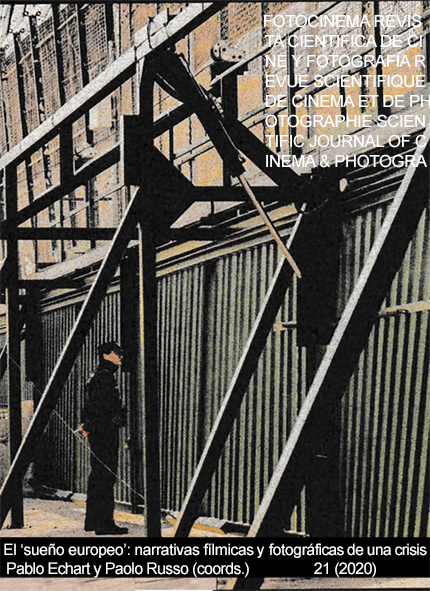El uso del zombi como construcción metafórica en la ficción televisiva. El caso de In the Flesh
DOI:
https://doi.org/10.24310/Fotocinema.2020.vi21.10020Palabras clave:
Television, metáfora, zombi, homofobia, George A. Romero, In the FleshResumen
Desde que en 1968 se estrenara La noche de los muertos vivientes (Night of the Living Dead, George A. Romero, 1968) el zombi ha funcionado como una de las figuras alegóricas más importantes del cine de terror. Ahora que las ficciones televisivas están de moda, convirtiéndose en uno de los fenómenos culturales más notables de los últimos tiempos, el género ha conseguido evolucionar gracias al formato serializado. El potencial metafórico que caracteriza a esta criatura se ha visto revitalizado por la aparición de narrativas que nos invitan a ponernos en su piel, dotándolo de capacidades cognitivas que lo convierten en protagonista de sus propias historias. Nuestro objetivo, por tanto, consiste en estudiar el origen de la humanización del muerto viviente y, por último, analizar la serie In the Flesh (BBC Three: 2013-2014), uno de los casos que mejor han sabido utilizar esta novedosa particularidad.
Descargas
Métricas
Publicación Facts
Perfil de revisores N/D
Información adicional autores
Indexado: {$indexList}
-
Indexado en
- Sociedad Académica/Grupo
- N/D
- Editora:
- Universidad de Málaga
Citas
Abbot, S. (2016b). Loss is Part of the Deal: Love, Fear and Mourning in TV Horror. En A. N. García Martínez (Ed.), Emotions in Contemporary TV Series (pp.155-171). Basingstoke, Reino Unido: Palgrave Macmillan UK.
Aiossa, E. (2018). The Subversive Zombie: Social Protest and Gender in Undead Cinema and Television. North Carolina, Estados Unidos: Mcfarland & Co Inc.
Benshoff, H. M. (1997). Monsters in the Closet: Homosexuality and the Horror Film. Manchester, Reino Unido: Manchester University Press.
Bishop, K. W. (2010). American Zombie Gothic: The Rise and Fall (and Rise) of the Walking Dead in Popular Culture. North Carolina, Estados Unidos: Mcfarland & Co Inc.
Bishop, K. W. (2015a). I always wanted to see how the other half lives: The Contemporary Zombie as Seductive Proselyte. En L. Hubner, M. Leaning y P. Manning (Eds.), The Zombie Renaissance in Popular Culture (pp.26-38). Basingstoke, Reino Unido: Palgrave Macmillan UK.
Bishop, K. W. (2015b). How Zombies Conquered Popular Culture: The Multifarious Walking Dead in the 21st Century. North Carolina, Estados Unidos: Mcfarland & Co Inc.
Cohen, J. J. (1996). Monster Culture (Seven Theses). En J. J. Cohen (Ed.), Monster Theory: Reading Culture (pp. 3-25). Minneapolis, Estados Unidos: University of Minnesota Press.
Dendle, P. (2007). The Zombie as Barometer of Cultural Anxiety. En S. Niall (Ed.), Monsters and the Monstrous: Myths and Metaphors of Enduring Evil (pp.45-57). Amsterdam, Países Bajos: Rodopi.
Enríquez Veloso, G. (2012). Intertextualidad en The Simpsons: Transgresión y ruptura formal. Ponencia llevada a cabo en el 10th World Congress of the International Association for Semiotic Studies (IASS/AIS), Coruña, España.
Jackson, C. (2017). This place. It's never going to accept people like us. Never ever: (Queer) Horror, Hatred and Heteronormativity in In the Flesh. En A. Szanter y J. K. Richards (Eds.), Romancing the Zombie: Essays on the Undead as Significant "Other" (pp.118-135). North Carolina, Estados Unidos: Mcfarland & Co Inc.
Jeffries, S. (5 de mayo de 2014). In the Flesh; The Man in the Hat – TV review. The Guardian. Recuperado de: https://www.theguardian.com/tv-and-radio/2014/may/05/in-the-flesh-tv-review
Jones, S. (2010). Implied…or Implode? The Simpsons’ Carnivalesque Treehouse of Horror. Animation Journal, 18, 56-79.
Manning, P. (2015). Zombies, Zomedies, Digital Fan Cultures and the Politics of Taste. En L. Hubner, M. Leaning y P. Manning (Eds.), The Zombie Renaissance in Popular Culture (pp.160-173). Basingstoke, Reino Unido: Palgrave Macmillan UK.
Mercer, K. (1993). Monster metaphors: notes on Michael Jackson's Thriller. En S. Frith, A. Goodwin y L. Grossberg (Eds.), Sound and Vision: The Music Video Reader (pp.93-128). Londres, Reino Unido: Routledge.
O'Connell, M. (13 de octubre de 2014). The Walking Dead Sets Another Ratings Record. The Hollywood Reporter. Recuperado de: https://www.hollywoodreporter.com/live-feed/walking-dead-sets-ratings-record-740324
O'Connell, M. (25 de octubre de 2016). TV Ratings: 'Walking Dead' Bloodbath Matches All-Time Audience High. The Hollywood Reporter. Recuperado de: https://www.hollywoodreporter.com/live-feed/tv-ratings-walking-dead-bloodbath-matches-all-time-audience-high-940924
Rogers, M. C., Epstein, M., y Reeves, J. L. (2002). The Sopranos as HBO Brand Equity: The Art of Commerce in the Age of Digital Reproduction. En D. Lavery (Ed.), This Thing of Ours: Investigating The Sopranos (pp.42-57). New York, Estados Unidos: Columbia University Press.
Tartaglione, N. (27 de enero de 2017). Resident Evil: The Final Chapter To Push Franchise Past $1B Global This Weekend. Deadline Hollywood. Recuperado de: https://deadline.com/2017/01/resident-evil-the-final-chapter-franchise-crossing-one-billion-dollars-global-box-office-1201895482/
Tenga, A., y Zimmerman, E. (2013). Vampire Gentlemen and Zombie Beasts: A Rendering of True Monstrosity. Gothic Studies, 15(1), 76-87. https://doi.org/10.7227/GS.15.1.8
Wood, R. (2003). Hollywood from Vietnam to Reagan and Beyond. New York, Estados Unidos: Columbia University Press.
Publicado
Cómo citar
Número
Sección
Licencia
Todos los contenidos publicados en Fotocinema. Revista científica de cine y fotografía están sujetos a la licencia Creative Commons Reconocimento-NoComercia-Compartirigual 4.0 cuyo texto completo puede consultar en <http://creativecommons.org/licenses/by-nc-sa/4.0>
Se pueden copiar, usar, difundir, transmitir y exponer públicamente, siempre que:
- Se cite la autoría y la fuente original de su publicación (revista, editorial y URL de la obra).
- No se usen para fines comerciales.
- Se mencione la existencia y especificaciones de esta licencia de uso.
Los derechos de autor son de dos clases: morales y patrimoniales. Los derechos morales son prerrogativas perpetuas, irrenunciables, intransferibles, inalienables, inembargables e imprescriptibles. De acuerdo con la legislación de derechos de autor, Fotocinema. Revista científica de cine y fotografía reconoce y respeta el derecho moral de los autores/as, así como la titularidad del derecho patrimonial, el cual será cedido a la Universidad de Málaga para su difusión en acceso abierto. Los derechos patrimoniales, se refieren a los beneficios que se obtienen por el uso o divulgación de las obras. Fotocinema. Revista científica de cine y fotografía se publica en open access y queda autorizada en exclusiva para realizar u autorizar por cualquier medio el uso, distribución, divulgación, reproducción, adaptación, traducción o transformación de la obra.
Es responsabilidad de los autores/as obtener los permisos necesarios de las imágenes que están sujetas a derechos de autor.














13.png)



